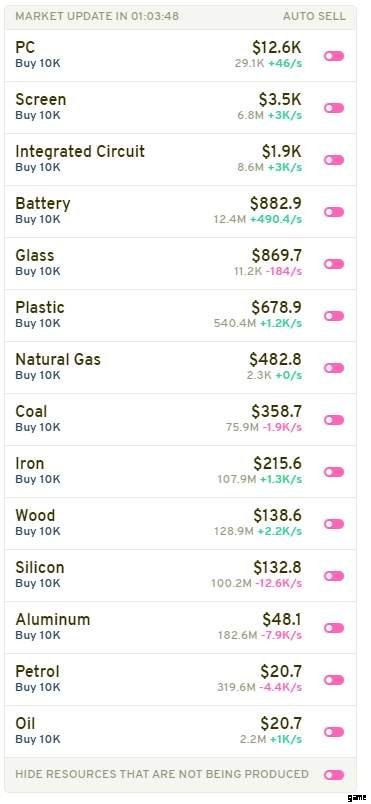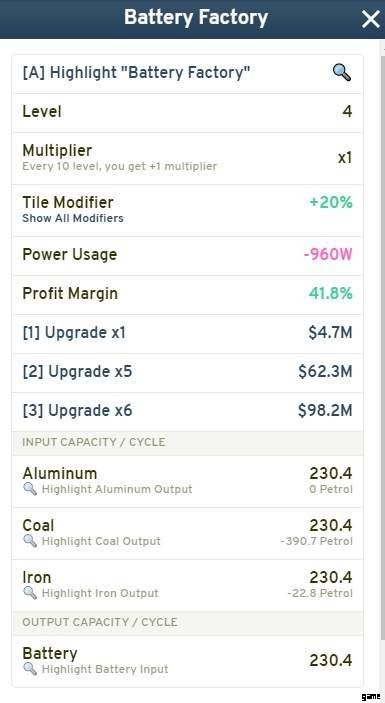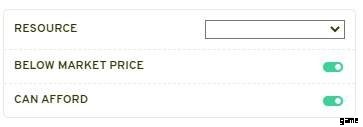
Ein Industry Idle-Leitfaden, der drei allgemeine Strategien und einige Tipps zur Entwicklung Ihrer eigenen Expansionsstrategie im Spiel umreißt.
Leitfaden für drei umfassende Strategien
Einführung
Dieser Leitfaden bietet drei Strategien in einem breiten Rahmen, aber denken Sie daran, dass jede dieser Strategien stark variieren kann, je nachdem, wie sie speziell verwendet werden, welche Karte verwendet wird und mehr.
No-Deficit-Strategien
Die No-Deficit-Methode ist eine Methode, bei der der Spieler alle notwendigen Materialien zur Herstellung von Konsumgütern selbstständig herstellt. (Jedes Produkt, das am Ende der Produktlinie dieses Herstellers steht) Bei dieser Methode werden Verbraucherprodukte dann verkauft (normalerweise über Auto-Sell oder eine Kombination aus Auto-Sell und Player-Trades) und die Einnahmen aus dem Verkauf dieser Produkte dienen der Finanzierung Expansion und das primäre Mittel zur Erhöhung der Marktkapitalisierung der Spieler.
Bei dieser Strategie stellt der Spieler Konsumgüter her, ohne irgendwelche Zwischenressourcen aus dem Handelszentrum oder dem Handelsbereich des Spielers kaufen zu müssen. Im Wesentlichen läuft die Produktion jedes Produkts gerade so hoch, dass alle Konsumgüter hergestellt werden können, oder mit einem kleinen Überschuss. Idealerweise gibt es bei der Produktion jedes Produkts einen kleinen Überschuss, damit der Spieler Großhandelsbestellungen ausführen kann.
Der Fortschritt bei der No-Deficit-Methode ist stetig, aber typischerweise langsamer, wobei der Spieler den Input/Output für jedes Verbraucherprodukt und seine Zusammensetzungen allmählich nivelliert und erhöht. Dies führt zu einer schrittweisen Umsatzsteigerung und zu keinen Betriebskosten. Karten-Resets mit der No-Deficit-Methode finden normalerweise statt, wenn der Spieler mit der Menge an $wiss zufrieden ist, mit der er zurückgesetzt werden kann (sie haben möglicherweise ein bestimmtes Upgrade / bestimmte Upgrades im Sinn) oder weil sie nicht mehr die Autosell-Kapazität haben, um alle zu verkaufen der Verbraucherprodukte, die sie herstellen.
Merkmale der Kein-Defizit-Methode
- Wachstum bei Umsatz und Marktkapitalisierung erfolgt schrittweise.
- Die Stabilität bei Produktion, Kraftstoff und Leistung ist sehr hoch.
- Es fallen keine ausgehenden Betriebskosten an.
- Diese Methode wird mit einem methodischeren Ansatz für Wachstum und Expansion verglichen.
Tipps für die No-Deficit-Methode
- Verlassen Sie sich nicht auf Produkte mit hoher Preisvolatilität (Bitcoin &Dogecoin)> Umsatzschwankungen verlangsamen Ihre Expansion, und ein Überschuss an diesen Ressourcen mit hoher Preisvolatilität erschwert in der Regel das Zurücksetzen, weil Sie das möchten auf einen guten Marktpreis dieser Produkte zu warten, um Ihre Marktkapitalisierung und die insgesamt erhaltenen US-Dollar zu erhöhen.
- Aktualisieren Sie Ihre Produktlinien in kleinen Intervallen; warte, bis sich dein Guthaben etwas erhöht hat, rüste langsam jeden Produktionsbereich auf und arbeite dich durch die Produktionslinie.
- Besonders während der mittleren und späteren Teile deines Laufs werden die Richtlinien:Schweres Eisen, Silicon Valley, Aluminiumschmelze, Industrielle Revolution, Entwaldung und Supercharge-Ölquelle besonders nützlich, da sie gleichzeitig deine notwendige Kraft, deinen Treibstoff und deine Ziehung erhöhen Politikpunkte bieten sie auch einen 2x effektiven Multiplikator (während die Politik aktiv ist) für die Produktion von:Eisen, Silizium, Aluminium, Kohle, Holz und Öl. Es kostet 720 Politikpunkte
- pro Sekunde, um alle diese Multiplikatoren gleichzeitig auszuführen, mehr, wenn Sie zusätzliche Richtlinien aktiviert haben.
- Es ist immer am besten, zuerst Ihre Low-Tier-Produkte zu aktualisieren, damit Sie die für die nächste Produktstufe erforderlichen Ressourcen haben, bevor Sie sie erstellen. Dies ist sinnvoll, um gar nicht erst ins Defizit zu geraten.
- Wenn Sie mit einem Defizit arbeiten, füllen Sie Ihre Defizite von der höchsten Stufe zur niedrigsten, sodass Sie die Anzahl der defizitären Produkte eliminieren und denselben Produktionstyp nicht wiederholt aktualisieren müssen.
- Planen Sie Ihre Baugebiete immer so, dass Sie Ihre Nachbarschaftscluster optimal optimieren (Clusterproduktion, um einen Nachbarschaftsbonus zu erhalten) und überprüfen Sie Ihre Kachelmodifikatoren in jedem Gebiet vor dem Bauen, um sicherzustellen, dass Sie maximale Produktivität erzielen.
- Wenn Sie einen übermäßigen Überschuss haben, suchen Sie diese Produkte im Statistikzentrum und stufen Sie Gebäude herab oder entfernen Sie sie, wenn möglich, um Genehmigungen zu erhalten.
Hochdefizite-Strategien
Die High-Deficit-Methode ist eine Methode, bei der der Spieler nur einige der notwendigen Materialien zur Herstellung seiner Konsumgüter produziert. (Jedes Produkt, das am Ende der Produktlinie dieses Herstellers steht) Bei dieser Methode werden Umsatz und Wachstum viel schneller erzielt und normalerweise auf viel höherem Niveau erreicht. Diese Methode führt jedoch zu hohen Betriebskosten, da Sie genügend Ressourcen kaufen müssen, um Ihr Defizit auszugleichen.
Bei dieser Methode werden Konsumgüter über Autosell oder eine Kombination aus Autosell und Spielerhandel verkauft, um Einnahmen zu akkumulieren, und der Kauf von Defizitgütern erfolgt über das Handelszentrum, den Spielerhandel oder häufiger durch die "Shopping Spree" -Richtlinie [ Erweiterungspaket 1]. Um die Finanzierung und die Marktkapitalisierung bei der Hochdefizitmethode zu erhöhen, müssen Ihre Einnahmen erheblich höher sein als die Kosten für den Kauf und Betrieb Ihres Unternehmens. Dies wird durch Gewinnspannen erreicht. Nachfolgend finden Sie eine kurze Aufschlüsselung, wie Gewinnspannen funktionieren und wie Sie Ihre Gewinne optimieren können, indem Sie überlegte Entscheidungen zur Produktion treffen.
Gewinnmargen funktionieren ganz einfach. Die Gewinnspanne eines Gebäudes ist der prozentuale Nettogewinn dieses Gebäudes im Gegensatz zum Einzelverkauf aller zusammengesetzten Elemente des Produkts. Nehmen Sie das Beispiel unten.


In diesem Beispiel verbraucht die Batteriefabrik 230,4 Aluminium, Kohle und Eisen, um 230,4 Batterien herzustellen. Die Preise für jeden Artikel sind im ersten Screenshot zu sehen. (Oben) Die Gesamtkosten für die Herstellung von 230,4 Batterien (wenn Sie die Ressourcen vom Handelszentrum gekauft hätten) betragen 143.400,96 $.
- (230,4 * 358,7) + (230,4 * 215,6) + (230,4 * 48,1)
Da 230.4 Batterien einen Gesamtverkaufspreis (oder -wert) von 203.420,16 $ haben, bringt die Produktion von Batterien in dieser Fabrik einen Gewinn von 60.019,2 $ (pro Produktionszyklus). Dieser Gewinn kann in den Einstandspreis geteilt werden, um die Nettogewinnspanne zu erhalten.
- ((60019.2 / 143400.96) * 100)
Diese Nettogewinnspanne liegt bei ~41,8 %, genau derselbe Wert wie in der Batteriefabrik. Ok, jetzt wissen Sie, was Gewinnspannen sind und wie sie ganz einfach mit einer Fabrik funktionieren. However, this applies to only one production. In reality, you will be producing things comprised of multiple composite products. In those cases, the net profit margin on the final factory will be the net profit margin that that factory is generating in regards to its own composite products, not the raw inputs required to create it. For example, Software Companies will show a profit margin that is based upon the profit returned from the prices of Phones, PCs, and Books in comparison with the value of Software.
It does not consider the materials to produce each of those respective composites. To calculate the profit margin for that entire production line leading up to and including that product (You would want to know this if your factories were producing intermediate products but purchasing the raw materials to produce those) you can sum up a list of all the raw materials involved in producing that product, and then run the same calculation that we saw above. The below equation will hence give you the profit margin for that production line (It assumes that there are 4 raw inputs involved in creating the end product).
- (((Quantity of Final Product Produced * Value of Final Product)- Total Costs) / Total Costs)
Where:
- Total costs =((Quantity of Input * Price of Input) + (Quantity of Input * Price of Input) + (Quantity of Input * Price of Input) + (Quantity of Input * Price of Input))
Profit margins are important in High-Deficit methods because they dictate how much profit you will make. If your production lines are making a negative profit margin, you will be losing money every second because your costs are outweighing your profits. Profit margins are not completely in your control, but in order to maximize your total profit margin and maximize profits, you should aim to extend your production lines as long as possible, since profit margins have a rolling effect down the production line. Note that resources for fuel and power can also be purchased using deficit methods such as the Shopping Spree policy. [Expansion Pack 1]
An often successful strategy within the High-Deficit Method is to have two main products or product types that you sell; one, typically with a more consistent market price (For example, Software &Consoles) that you sell constantly, and another, typically more volatile (Internet or Dogecoin) that you produce at a lower rate than you can autosell, but only sell when the price is optimal. This gives you a consistent revenue stream and makes the most of production efficiency (not allocating too much of your resources to high volatility products) while giving boost sell points as well. However, there are countless variations and ways to operate your company in a deficit, this is just an example I’ve personally observed.
Features of the High Deficit Method
- Growth in revenue and market cap is typically unstable but rapid in times of growth.
- Small falls in culture production (to run shopping spree and production policies) will bring things to a halt; your run is much more fragile.
- Stability in production, fuel, and power is very low.
- There are outgoing costs which have to be outweighed by your total revenue.
- This method is likened to a more sporadic and aggressive approach to expansion.
- Purchased deficits may be used to lighten the strain on permits or to completely replace the majority of production.
Tips for the High Deficit Method
- Just because you’re using a more profit-aggressive method, try to act methodically. Mindlessly upgrading things as soon as you can finance them is typically a bad idea. If you over expand one chain and receive a negative profit margin you could see a serious fall in profit.
- It’s a good idea to allocate your limited production inputs to the more expensive materials that are specific to your location. If plastic prices are high on your map, try producing plastic independently and buying a majority share in the rest of your resources.
- Always upgrade your factories from the simplest moving toward more and more complex products. This will ensure that your purchases [Shopping Spree] will be that of the lowest tier and not something part way up the production chain.
- Don’t use this strategy needlessly. If you have the cash and plenty of remaining permits, it’s best to produce more resources independently and purchase a smaller share. This strategy is more intended for permit-tight situations, late game expansion, or specializing purchases for specific low quantity resources.
- When having a moderate to high reliance on this strategy, try and keep your major purchasing inputs close to your trade center. You want to really centralize production as much as possible because the Shopping Spree purchases [Expansion Pack 1] and any other purchases from the trade center or player trading will be sent to your trade center. Having a distanced production line will massively increase your fuel consumption and may even cause disruptions in resource flow.
Price &Volume Trading Methods
Market Trading is, in my opinion, mostly a sub-strategy and will barely ever be used as a main revenue stream before end-game progression. However, to completely ignore market trading methods as a part of your progression is adverse.
Trading items on the market (And by market I am referring to both offline trade center and online player trade markets) is a great way to increase your revenue, clear extra stock from mounting surpluses, make the most of your market cap on resets, and turn earned revenue into more revenue.
Since this is such a broad category and I don’t plan to outline any very specific market elements in this guide, I’m just going to run over some helpful tips and strategies for trading on the market in Industry Idle. Note that trading becomes more relevant as you progress in the game. If you are on one of your first runs, this information may not be helpful. Market trading is also helpful if you don’t have a lot of time to actively expand and can instead wait to fill orders and check market prices whenever you get the chance.
Tips:when &how to trade (For the best results)
Having foresight about when you plan to liquidate and reset are important for market trading. A good strategy during the hours (or days) leading up to reset is to save up cash and wait for a product priced under it’s typical market valuation. Then, buy as great a volume of the product as you can (using saved cash), and when there’s an upturn in the market, reset using your inflated market cap or autosell the product for profits is the stock rating is unfavourable to reset at that time. This strategy is good at any point in progression, not just before reset, but keep in mind that it’s most beneficial in the later stages when saving cash makes more sense than spending it on upgrading your production.
Another way to quickly make marginal gains in your market cap is to search the player market using the ‘Below Market Price’ &‘Can Afford’ filter toggles. Keep in mind this does not impede on your player trade quota. Holding onto these products or reselling them for a profit immediately afterward is a good way to make small jumps in market cap with excess cash.

Produce a surplus with intent to sell on the online market. A good idea is to produce a modest surplus in a product you are already autoselling. This means that when the price is most favourable and people are looking to liquidate their products rather than purchase more (at market price), you can sell your surplus on the online market at a reasonable way below the market price. People with higher autosell capacity or looking to reset will see this as a way to quickly increase valuation and you will in turn receive a heavy bonus.
Run stop-losses on the market! For those who don’t know, stop-loss orders are orders where, if the price falls or rises past a certain point, you automatically fill or place an order. This is useful so that even if you aren’t online, or if you’re working on other things, you can be buying products at lows and selling at highs. In Industry Idle, this can be (somewhat) replicated by placing low price buy orders and high price sell orders. Keep in mind there will be a cap to how far you can push the limits, depending on the market price, and you need the product in stock to make a sell order.
Search through buy orders first before making a sell order, there may be a product being ordered at a higher price than you would offer. At the moment there is no system to automatically fill your order if supply/demand prices cross over like this but I expect it won’t happen any time soon because the way the market currently works is that the entire quantity of an order has to be filled. Having this change would result in drastic market changes.
